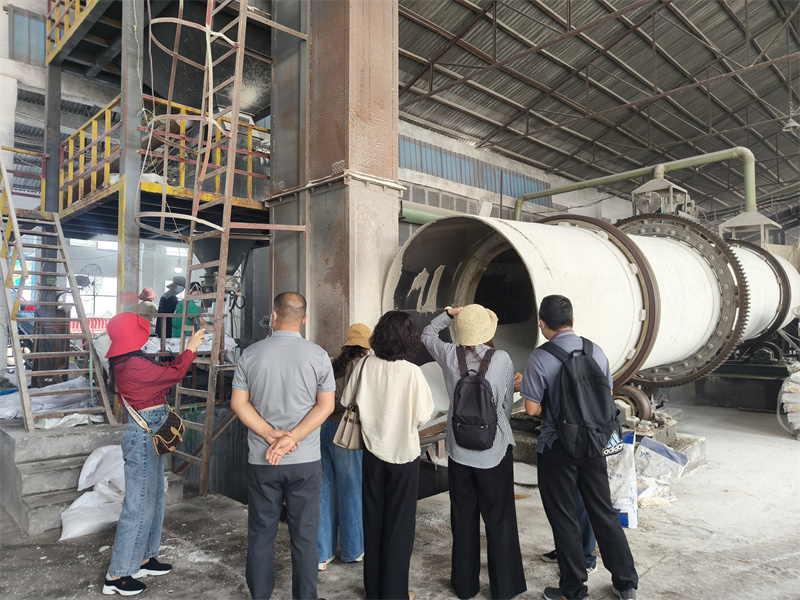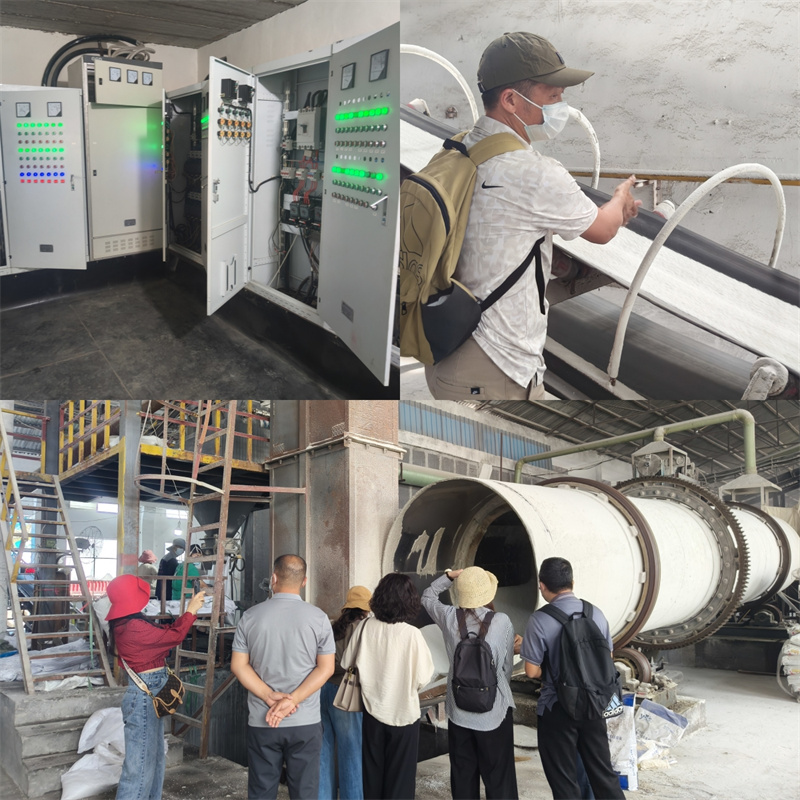

6位越南客户来到我司参观,其对NPK生产线非常感兴趣,于是我们联系到许昌的老客户去那里看NPK生产线现场。客户抵达现场后被工作中的机器所吸引,并且对制造出来的颗粒赞不绝口,通过客户的现场参观反馈比较满意,后续将会和我们促成合作。
那么什么是NPK转鼓造粒生产线?怎么配置NPK转鼓造粒生产线?
NPK转鼓造粒生产线是一种用于生产复合肥(氮、磷、钾元素混合肥料)的常见工艺,其核心是通过转鼓造粒机将原料混合、造粒、干燥和筛分,*终得到颗粒均匀的复合肥产品。以下是典型的工艺流程及关键步骤:
1. 原料准备与配料
原料选择:根据配方要求,准备氮(N)、磷(P)、钾(K)原料及其他添加剂(如微量元素、黏结剂等)。
氮源:尿素、硫酸铵、氯化铵等。
磷源:磷酸一铵(MAP)、磷酸二铵(DAP)、过磷酸钙等。
钾源:氯化钾、硫酸钾等。
配料系统:通过电子皮带秤或计量设备,按比例**混合原料,确保NPK比例符合产品要求。
2. 混合与粉碎
混合:将配料后的原料送入混合机(如双轴桨叶混合机)充分混合,形成均匀的粉状物料。
粉碎:若原料有结块,需通过粉碎机(如链式破碎机)粉碎至合适粒度,保证后续造粒效果。
3. 转鼓造粒
造粒机:混合后的粉料进入转鼓造粒机(旋转圆筒),同时喷入蒸汽或水(或黏结剂溶液)以增加物料黏性。
成粒原理:在转鼓的旋转作用下,粉料通过团聚和涂层层积逐渐形成小颗粒(1-4mm)。
反应控制:部分配方(如含磷酸盐)可能在造粒过程中发生化学反应(如氨化),需控制pH和温度。
4. 干燥
干燥机:湿颗粒从造粒机排出后,进入回转干燥机(热风温度通常为100-200℃),降低水分至≤2%。
热源:燃煤、天然气或燃油热风炉提供热风,需避免过高温度导致尿素熔化或养分损失。
5. 冷却
冷却机:干燥后的热颗粒通过回转冷却机(或流化床冷却器)与冷空气交换热量,降至室温,防止结块并提高颗粒强度。
6. 筛分与返料
筛分:冷却后的颗粒通过振动筛分级,合格颗粒(如2-4mm)进入包膜工序,过大或过小的颗粒经破碎后返回造粒机(返料系统)。
返料比:控制返料量是保证连续生产的关键,通常返料量占新料的20-50%。
7. 包膜(可选)
包膜机:合格颗粒表面喷涂防结块剂(如硅油、滑石粉)或缓释涂层,改善储存性和缓释效果。
8. 成品包装
计量包装:颗粒通过自动包装机称重,装入编织袋或吨袋,封口后入库。
9. 尾气处理
环保系统:干燥和冷却环节的尾气需经旋风除尘、洗涤塔或布袋除尘处理,达标后排放。
关键控制点
1. 水分控制:造粒时水分影响成粒率,干燥后水分需达标。
2. 温度控制:避免过高温度导致尿素分解或颗粒变形。
3. 返料平衡:维持返料与新料比例稳定,确保造粒连续性。
4. 颗粒强度:通过调整黏结剂用量和干燥条件优化强度。
工艺特点
优点:连续化生产、产能大(可达30万吨/年)、适应多种配方。
缺点:能耗较高,返料量大,需精细控制参数。
此工艺可根据原料特性(如高氮或高磷配方)调整细节,例如添加酸性调节剂或改变造粒湿度。
What is NPK rotary drum granulation production line?
Six Vietnamese customers came to visit our company. They were very interested in the NPK production line, so we contacted old customers in Xuchang to see the NPK production line there. After arriving at the site, the customers were attracted by the working machines and praised the produced pellets. The feedback from the customers' on-site visit was quite satisfactory, and they will cooperate with us in the future.
So what is the NPK rotary drum granulation production line? How to configure the NPK rotary drum granulation production line?
NPK Drum Granulation Production Line Process Flow
The NPK drum granulation production line is a common process for manufacturing compound fertilizers (blends of nitrogen, phosphorus, and potassium). Its core involves mixing raw materials, granulation in a rotary drum, drying, and screening to produce uniform fertilizer pellets. Below is a typical process flow and key steps:
1. Raw Material Preparation & Batching
Material Selection: Based on the formula, prepare nitrogen (N), phosphorus (P), potassium (K) sources, and additives (e.g., micronutrients, binders).
Nitrogen sources: Urea, ammonium sulfate, ammonium chloride, etc.
Phosphorus sources: Monoammonium phosphate (MAP), diammonium phosphate (DAP), superphosphate, etc.
Potassium sources: Potassium chloride, potassium sulfate, etc.
Batching System: Use electronic belt scales or metering devices to precisely mix raw materials according to the NPK ratio requirements.
2. Mixing & Crushing
Mixing: The batched materials are fed into a mixer (e.g., dual-shaft paddle mixer) to achieve a homogeneous powder blend.
Crushing: If raw materials contain lumps, a crusher (e.g., chain mill) is used to reduce particle size for better granulation.
3. Drum Granulation
Granulator: The mixed powder enters a rotary drum granulator, where steam or water (or a binder solution) is sprayed to increase adhesion.
Pellet Formation: Under the drum’s rotation, fine particles agglomerate and grow into small granules (1–4 mm) through layering and coalescence.
Reaction Control: Some formulations (e.g., phosphate-based) may undergo chemical reactions (e.g., ammoniation), requiring pH and temperature control.
4. Drying
Dryer: Wet granules from the granulator are transferred to a rotary dryer (hot air temperature typically 100–200°C) to reduce moisture to ≤2%.
Heat Source: Hot air is supplied by coal, natural gas, or oil-fired furnaces. Excessive temperatures must be avoided to prevent urea melting or nutrient loss.
5. Cooling
Cooler: Dried hot pellets are cooled in a rotary cooler (or fluidized bed cooler) with ambient air to room temperature, preventing caking and improving hardness.
6. Screening & Recycling
Screening: Cooled granules are classified via vibrating screens. On-size pellets (e.g., 2–4 mm) proceed to coating, while oversized/undersized particles are crushed and recycled back to the granulator (return system).
Recycle Ratio: Controlling the return rate (typically 20–50% of fresh feed) is critical for continuous operation.
7. Coating (Optional)
Coating Drum: Qualified granules are coated with anti-caking agents (e.g., silicone oil, talc) or slow-release coatings to enhance storage and controlled-release properties.
8. Packaging
Weighing & Bagging: Pellets are weighed by automatic packers and filled into woven bags or bulk bags before sealing and storage.
9. Exhaust Gas Treatment
Emission Control: Exhaust gases from drying and cooling are treated via cyclones, scrubbers, or bag filters to meet environmental standards.
Key Control Points
1. Moisture Control: Granulation moisture affects pellet yield; post-drying moisture must meet specifications.
2. Temperature Control: Excessive heat can degrade urea or deform pellets.
3. Recycle Balance: Maintain a stable ratio of recycled to fresh feed for continuous granulation.
4. Pellet Strength: Optimized by adjusting binder dosage and drying conditions.
Process Characteristics
Advantages: Continuous production, high capacity (up to 300,000 tons/year), adaptable to various formulations.
Disadvantages: High energy consumption, significant recycle load, and precise parameter control required.
咨询热线
HOTLINE
郑州浩天机械有限公司
联系电话:15803898630
公司地址:荥阳市塔山南路